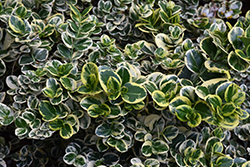It's all about ...
plants

Humphreyi Variegata Carissa
Carissa macrocarpa 'Humphreyi Variegata'
Height: 3 feet
Spread: 4 feet
Sunlight:
![]()
![]()
Hardiness Zone: 9a
Other Names: Natal Plum
Description:
A compact, low growing, bushy evergreen shrub that forms a great low hedge or groundcover; waxy green leaves variegated with cream and pale yellow; blooms primarily in spring and summer, and produces edible fruits; very drought tolerant once established
Edible Qualities
Humphreyi Variegata Carissa is a small shrub that is commonly grown for its edible qualities, although it does have ornamental merits as well. It produces red oval berries which are typically harvested when mature. The berries have a tart taste.
The berries are most often used in the following ways:
- Cooking
- Preserves
Features & Attributes
Humphreyi Variegata Carissa has attractive creamy white-variegated dark green foliage with hints of grayish green which emerges buttery yellow in spring on a plant with an upright spreading habit of growth. The glossy round leaves are highly ornamental and remain dark green throughout the winter. It features dainty fragrant white star-shaped flowers along the branches from early to late summer. It produces red berries from early fall to early winter.
This is a dense multi-stemmed evergreen shrub with an upright spreading habit of growth. Its average texture blends into the landscape, but can be balanced by one or two finer or coarser trees or shrubs for an effective composition. This is a relatively low maintenance plant, and is best pruned in late winter once the threat of extreme cold has passed. It is a good choice for attracting birds and butterflies to your yard, but is not particularly attractive to deer who tend to leave it alone in favor of tastier treats. Gardeners should be aware of the following characteristic(s) that may warrant special consideration;
- Spiny
Aside from its primary use as an edible, Humphreyi Variegata Carissa is sutiable for the following landscape applications;
- Mass Planting
- General Garden Use
- Groundcover
- Container Planting
Planting & Growing
Humphreyi Variegata Carissa will grow to be about 3 feet tall at maturity, with a spread of 4 feet. It has a low canopy. It grows at a slow rate, and under ideal conditions can be expected to live for approximately 20 years. This is a self-pollinating variety, so it doesn't require a second plant nearby to set fruit.
This shrub is quite ornamental as well as edible, and is as much at home in a landscape or flower garden as it is in a designated edibles garden. It does best in full sun to partial shade. It prefers to grow in average to moist conditions, and shouldn't be allowed to dry out. This plant does not require much in the way of fertilizing once established. It is not particular as to soil pH, but grows best in rich soils, and is able to handle environmental salt. It is somewhat tolerant of urban pollution. This is a selected variety of a species not originally from North America.
Humphreyi Variegata Carissa is a good choice for the edible garden, but it is also well-suited for use in outdoor pots and containers. With its upright habit of growth, it is best suited for use as a 'thriller' in the 'spiller-thriller-filler' container combination; plant it near the center of the pot, surrounded by smaller plants and those that spill over the edges. It is even sizeable enough that it can be grown alone in a suitable container. Note that when grown in a container, it may not perform exactly as indicated on the tag - this is to be expected. Also note that when growing plants in outdoor containers and baskets, they may require more frequent waterings than they would in the yard or garden. Be aware that in our climate, most plants cannot be expected to survive the winter if left in containers outdoors, and this plant is no exception. Contact our experts for more information on how to protect it over the winter months.
This plant is not reliably hardy in our region, and certain restrictions may apply; contact the store for more information.
